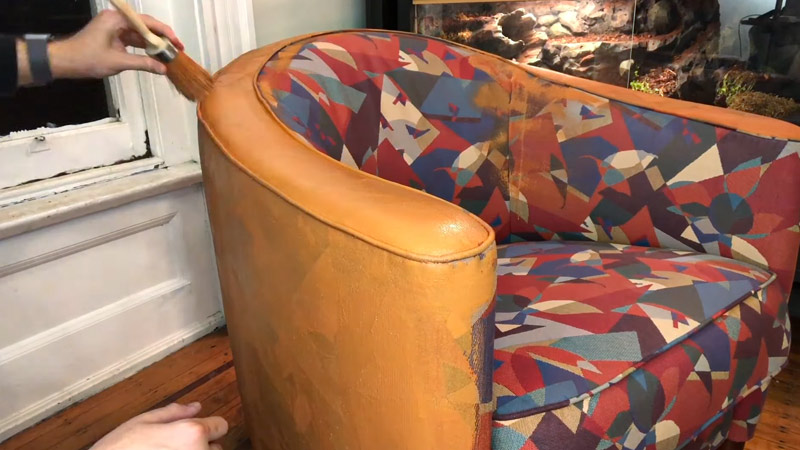Fabric paint, renowned for its adaptability to textiles, has captured the imagination of artists and hobbyists alike. Yet, a question lingers: Does fabric paint possess the power to breathe life into the exquisite world of leather?
This exploration delves into the compatibility of fabric paint with leather, unraveling the possibilities it offers to revitalize and transform leather items into personalized works of art.
As we embark on this journey, we shall uncover the techniques, challenges, and secrets behind unleashing the true potential of fabric paint on the timeless canvas of leather.

Does Fabric Paint Work on Leather?
Yes, fabric paint can work on leather, but there are several important considerations to keep in mind when using it on this particular material:
Surface Preparation
Properly preparing the leather surface is crucial for the successful adhesion of fabric paint. Clean the leather thoroughly to remove any dirt, oils, or residues that could interfere with the paint’s ability to bond to the surface.
Type of Leather
The success of using fabric paint on leather can vary depending on the type of leather. Smooth, non-textured leathers tend to work better than heavily textured or suede-like leathers. Aniline or semi-aniline leathers might absorb the paint differently compared to coated or finished leathers.
Flexibility and Cracking
Leather is a flexible material that moves and stretches. Regular fabric paint might not have the same flexibility as leather, which can lead to cracking or flaking over time. To mitigate this, choose fabric paints that are specifically designed for use on leather or flexible materials.
Testing
Before applying fabric paint to a large, visible area of the leather, it’s recommended to perform a test on a small, inconspicuous spot. This will help you assess how well the paint adheres, how it looks, and how it reacts to the leather’s flexibility.
Paint Type

Use paints that are formulated for use on fabric and leather. These paints are designed to adhere well to a variety of surfaces, including leather, and are more likely to maintain their appearance over time.
Application Technique
Apply the fabric paint in thin, even layers. Multiple thin layers are generally better than one thick layer, as they allow for better adhesion and flexibility. Use a brush, sponge, or airbrush to apply the paint, depending on the effect you’re trying to achieve.
Sealing
After the paint has dried, consider applying a clear, flexible sealant or finish specifically designed for leather. This can help protect the paint from wear, moisture, and other environmental factors, as well as enhance the longevity of your design.
Maintenance
Keep in mind that using fabric paint on leather may require special care to maintain the appearance of the paint over time. Avoid excessive rubbing, scratching, or exposure to harsh elements that could compromise the paint’s integrity.
Aging and Patina
Leather naturally develops a patina and changes in appearance over time due to wear and exposure. The fabric paint might also be affected by this aging process, so be prepared for potential changes in the paint’s appearance as the leather ages.
Professional Assistance
If you’re working with valuable or sentimental leather items, or if you’re unsure about the process, it’s advisable to seek the expertise of professionals who specialize in leather customization and restoration.
Key Considerations Before Using Fabric Paint on Leather
Before diving into a leather painting project with fabric paint, it’s crucial to consider several factors to ensure optimal results:
Leather Type
Not all leathers are created equal. Some leathers are more receptive to paint than others due to variations in surface texture, finishing, and dyeing processes.
Full-grain leather with a smooth surface may be more suitable for painting, while heavily treated, waxed, or oily leathers may not be as compatible.
Leather Finish
Leather products often come with various finishes, such as aniline, semi-aniline, pigmented, or suede. Each finish can affect how the paint adheres to the surface and the final appearance of the artwork.
Leather Pre-treatment
Preparing the leather surface is crucial to ensure proper paint adhesion. Cleaning the leather to remove any dirt, oils, or residues is essential. Some artists also choose to lightly sand the surface to create a better bonding surface for the paint.
Choice of Fabric Paint
Selecting the right fabric paint is critical for success. Water-based fabric paints are generally recommended for leather because they are more flexible and have a better chance of adhering to the leather surface.
Compatibility Test
Before starting a large-scale project, it is highly advisable to perform a small compatibility test on a hidden area of the leather item.
This test will help determine how well the fabric paint adheres to the specific leather type and finish and whether any undesirable reactions occur.
Permanency and Durability
Depending on the intended use of the painted leather item, it’s essential to consider the permanency and durability of the fabric paint. Sealants or protective topcoats may be necessary to ensure the longevity of the artwork.
How Do You Use Fabric Paint on Leather?
When applying fabric paint on leather, it’s crucial to adopt the right techniques to achieve the desired results.
Here is a step-by-step guide on how to use fabric paint on leather:
Surface Preparation
As mentioned earlier, clean the leather thoroughly to remove any dust, dirt, or grease that might hinder paint adhesion. A mild soap or leather cleaner, along with a soft cloth or sponge, can be used for this purpose. Avoid using harsh chemicals or abrasive cleaning agents that may damage the leather.
Leather Flexibility
Keep in mind that leather is a flexible material that can expand and contract. To prevent cracking of the paint when the leather bends or stretches, use fabric paint that is specifically designed to be flexible and resistant to cracking.
Paint Application
Apply the fabric paint evenly on the leather surface using a soft brush, sponge, or airbrush. It’s essential to avoid using excessive amounts of paint, as it may lead to a thick layer that affects the leather’s flexibility. Instead, apply multiple thin layers, allowing each one to dry before applying the next.
Drying Time
Follow the fabric paint manufacturer’s instructions regarding drying times. Typically, fabric paints dry relatively quickly, but it’s essential to be patient and let each layer fully dry before proceeding with additional layers or any additional painting techniques.
Blending and Layering
Just like painting on fabric, blending and layering techniques can be used to create depth and dimension in your artwork. This allows for the creation of intricate designs and shading effects that add realism and beauty to the painted leather item.
Fixing the Paint
Once the paint has dried and the artwork is complete, it’s important to set the paint to ensure its permanence. Some fabric paints may require heat-setting with iron, while others may be set using a hairdryer. Check the manufacturer’s instructions for the appropriate method.
Challenges and Issues of Painting Leather With Fabric Paint
Painting leather with fabric paint can be a rewarding creative experience, but it also comes with its fair share of challenges and potential issues:
Absorption and Texture
Leather is naturally absorbent, and its texture can vary significantly. The absorbency of the leather may impact how the paint adheres and spreads on the surface.
In some cases, this can lead to a less defined or blended appearance, especially with water-based fabric paints.
Cracking and Peeling
If the wrong type of fabric paint is used or if the leather is not adequately prepped, there is a risk of the paint cracking, peeling, or flaking over time. This is especially problematic for leather items that undergo frequent bending or stretching.
Color Intensity
The color intensity of the fabric paint may differ on leather compared to fabric. This is due to the inherent differences in the two materials’ surfaces and absorption rates.
Artists may need to adjust their painting techniques and apply additional layers to achieve the desired color vibrancy.
Durability and Wear
Leather items, such as jackets or shoes, are often subjected to wear, exposure to the elements, and other stresses. The painted artwork should be adequately protected with a sealant or protective topcoat to enhance its durability and resistance to fading.
Bleeding and Feathering
In some cases, fabric paint may bleed or feather on the leather surface, especially if the paint is applied too heavily. This can result in unintended color spreading and a less precise finish.
Tips for Successful Leather Painting with Fabric Paint
To ensure a successful leather painting project with fabric paint, here are some valuable tips to keep in mind:
Choose the Right Fabric Paint
Opt for water-based fabric paint, as it tends to be more flexible and suitable for leather surfaces. Read product labels and descriptions to find paint that specifically mentions compatibility with the leather.
Test on a Scrap Leather
Before starting your main project, test the fabric paint on a scrap piece of leather to understand how it interacts with the specific leather type and finish you plan to paint.
Gradual Layering
Build up the paint layers gradually, allowing each layer to dry completely before applying the next. This will help achieve more vibrant colors and prevent excessive buildup of paint.
Thin and Even Coats
Apply thin and even coats of fabric paint to ensure the leather retains its flexibility and natural texture. Avoid overloading the surface with paint.
Seal and Protect
Once the paint has dried, apply a protective topcoat or sealant specifically designed for leather to safeguard the artwork from wear, tear, and fading. Test the protective product on a hidden area first to check for any adverse reactions.
Experiment with Techniques
Fabric paint offers a variety of techniques, such as stenciling, stamping, and freehand painting. Don’t be afraid to experiment and combine techniques to create unique and stunning designs.
Patience and Practice
Leather painting requires patience and practice. Don’t be discouraged if your first attempts don’t turn out as expected. With practice, you will refine your skills and achieve impressive results.
FAQs
While fabric paint can work on many types of leather, it may not adhere well to heavily treated, waxed, or oily leather.
It is essential to test the fabric paint on a small, inconspicuous area of the leather item before proceeding with a full-scale project.
When applied correctly, fabric paint should not drastically alter the texture of the leather.
While it is possible to use fabric paint on suede leather, it may not yield the same results as on smooth leather surfaces.
Fabric paint can be used on leather with a glossy finish, but it may require additional preparation steps.
While fabric paint is designed to be durable and withstand washing on fabrics, it may not hold up as well on leather items subjected to frequent washing.
Conclusion
Fabric paint can be successfully used on leather, opening up exciting opportunities for artists and crafters to personalize leather items with their creative flair.
While challenges may arise, such as adhesion issues, color intensity, and potential cracking, careful preparation, the right choice of fabric paint, and protective finishing can overcome these obstacles.
So, unleash your creativity, and let your imagination flow as you explore the fascinating world of leather painting with fabric paint.
Leave a Reply